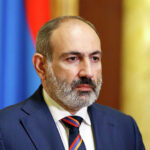Photo by Azertac.
In recent weeks, tensions between Armenia and Azerbaijan have once again flared up despite clear stipulations outlined in the trilateral peace agreement signed by Armenia, Azerbaijan, and Russia in November 2020. On May 12, the government of Armenia announced that the Azerbaijani military had advanced into its territory in the southern Syunik province of the country. By May 20, the country also reported a series of clashes with Azerbaijani troops that left several Armenian soldiers injured. On May 25, Armenia’s Ministry of Foreign Affairs announced that an Armenian serviceman was fatally wounded by Azerbaijani armed forces, a claim that Azerbaijan denies.
The latest development highlights the multiple challenges in the post-conflict reality of the region. On May 27, Azerbaijani officials reported that six Armenian soldiers had been captured in the Kelbajar region. According to Armenian news outlet NEWS.am, the six Armenian soldiers were captured by Azerbaijani troops while carrying out engineering work near their military facility in the Gegharkunik Province.
Azerbaijani officials, on the other hand, have stated that the Armenians were sappers involved in scouting defenses and laying landmines. According to Lieutenant Colonel Anar Eyvazov, the Spokesperson for the Azerbaijani Defense Ministry, the soldiers were part of a ‘sabotage group’ operating in the Yukhary Ayrim village. Eyvazov also stated that Armenia assembled its forces, including tank formations, at the front line.
In the post-war setting, the issue of landmines has become a hot topic. Landmines have caused military and civilian casualties on both sides of the conflict, and following the end of the second Karabakh war, assessments have shown that it will take at least five to six years to clear unexploded ordinance and a minimum of ten years to clear landmines. Azerbaijan’s National Agency for Mine Action (ANAMA) is working to clean the reclaimed territories with a force of more than 15,000 personnel. Russian military personnel and personnel from Turkey’s Special Mine Detection and Clearance Teams are contributing to demining efforts.
The Armenian government has also asserted that its soldiers had not crossed into Azerbaijani territory, highlighting another challenge of stabilizing the situation in the region. With the first Karabakh war erupting in the wake of the collapse of the Soviet Union, Armenia and Azerbaijan never officially demarcated a border. During the second Karabakh war, Azerbaijan presented itself as a force simply restoring its territorial integrity under its internationally recognized borders. With the latest move, however, Azerbaijan has literally pushed past this boundary into uncharted territory, highlighting the need for negotiations between Armenia and Azerbaijan in establishing official boundaries.
Following the announcement of the arrests, members of the international community jumped to voice their concerns. The U.S. Department of State released a statement calling for Armenia and Azerbaijan to ‘urgently and peacefully resolve this incident’ and for Azerbaijan to release the six prisoners, as well as any prisoners of war. The U.S. government also demonstrated awareness for the problems caused by the lack of border demarcation, noting that both Armenia and Azerbaijan should return to their positions that they held on May 11.
France’s Foreign Ministry issued a similar announcement, calling on both sides to ‘show the utmost restraint and to refrain from any provocation.’
Noticeably silent in the recent developments of this month is Russia. Russia, which maintains a presence of nearly 2,000 peacekeepers in Nagorno-Karabakh, has not issued a firm warning on the detention of the soldiers. On May 27, it was reported that Armenian Prime Minister Nikol Pashinyan had requested international observers from ‘Russia or other countries’ to be deployed to the Armenian border where the latest incidents have occurred. Sergey Kopirkin, Russia’s Ambassador to Armenia, only issued a generic response during a recent press conference, claiming that Russia is making efforts to resolve the situation in Syunik without providing any further details. Prime Minister Pashinyan has also made numerous appeals to the CSTO, which he claims ‘has not expressed a clear position’ and ‘has not declared that Azerbaijan should withdraw its forces.’
For now, the situation remains unresolved, but highlights the need for border demarcation as well as acknowledgement for the danger of the extensive mining in the region. Rather than simply issuing statements, the international community and international organizations should lead on-the-ground missions in Armenia and Azerbaijan to establish solutions to the smoldering components of the conflict, in order to prevent further escalation of conflict.

